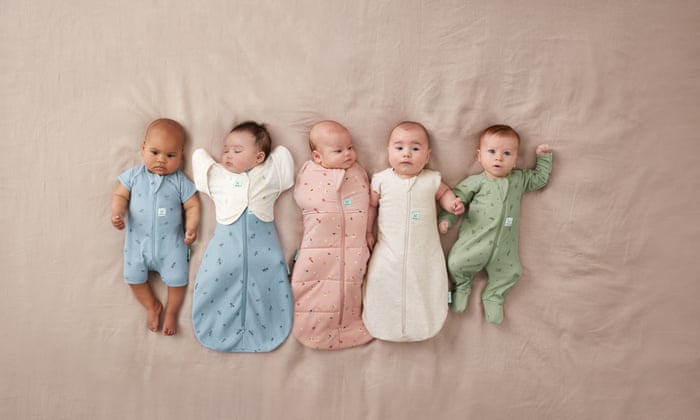The best baby sleep: parents and an expert share their secrets | Ergopouch: Safe and sound
Ah, sleep. In the first years of your little one’s life it can be an elusive beast. Just when you think you’ve grasped your child’s nocturnal habits, they mix it up again.
“We tend to think sleep is a luxury,” says Tara Mitchell, a Perth-based infant and toddler sleep specialist. “But it’s the foundation of wellbeing.”
The former paediatric nurse, a mother of three, has spent 10 years working with families to improve their sleeping patterns and knows quality rest is essential not only for tired parents, but growing kids too.
“During our little ones’ sleep, consolidation of memory happens around things they’ve learnt during the day,” she says. “Their cells repair, they rest and digest. Sleep determines mood, focus, attention and sets them up for their day ahead.”
Mitchell believes healthy sleep habits are the most important skills parents can teach children.
We asked the sleep specialist and two Australian parents to share their tips for a smooth bedtime routine.
1. Optimise wake windows
Mitchell acknowledges that children thrive on consistency. However, with three children of her own, she also believes parents need to give themselves permission to be flexible.
“If you miss a nap or you’re out and about, try not to get caught up on it,” she says. “It’s about having flexibility within that structure and finding a routine that’s not going to add too much pressure or anxiety.”
Parents should be aware of the amount of sleep needed for their child’s age, she says, and it’s important they make sure their kids get tired enough to sleep.
“We often see sleep refusal or difficulty settling because they’ve had that rest while feeding or during screen time. So, in that awake time make sure you’re expending energy, allowing them to build up that pressure for sleep.”
2. Control the temperature
Managing a baby’s temperature is one of the biggest stresses for parents, says Mitchell, who has partnered with the Melbourne-based sleepwear brand ergoPouch and believes the business’s layering guide provides the reassurance parents need.
“It is a great foundation that means parents have a universal language to be able to talk to each other about what their little ones are wearing.”
Catherine McKay, Australian mother of two, agrees. “The layers guide saved me a lot of worrying and wondering [how to dress the children] during the baby years.”
The guide includes a simple diagram showing how many items your child should wear, depending on the temperature. It takes the guesswork out of sleep-time dressing, and when you’re sleep-deprived and have decision fatigue, that means there’s one less thing to spend energy on.
“I always recommend it for new mums,” McKay says.
3. Dress for success
As well as being good for sensitive baby skin, breathable materials such as organic cotton can help regulate a baby’s temperature. Opt for sleepwear with a thermal overall grade (TOG) rating so you can be sure they’re wearing the right layers for the time of year and environment, from a lightweight 0.2 TOG in warmer months to 3.5 TOG when it’s cool.
A room thermometer can help you monitor the bedroom temperature. Conveniently, ergoPouch’s babywear comes with one.
The cost of baby clothes can quickly add up, and it can pay to invest in enduring items that will grow with the child and can be handed down.
Phoebe Cousins-Palmer, a mother of two from Victoria’s Mornington Peninsula, says: “Now that my 11-month-old is able to stand and wants to get up and look for me as soon as she’s awake, I’ve zipped what was a sleep sack into individual legs to enable her to move more freely.”
McKay says: “We were given [ergoPouch sleepwear] as a gift for our first baby and I used them until he was about three.
“Now his brother uses all the same ones. They’ve been washed and dried a hundred times over and are still going strong.”
4. Embrace light and shade
Blackout blinds can help reduce the amount of light creeping into the sleep environment, which can interrupt melatonin production.
“When my son was tiny, we swore by blackout blinds to help him get solid naps and slightly longer stretches during the night,” McKay says. “A dark and cosy space mimics being in the womb.”
However, choosing to not completely darken the space may mean your little one gets used to falling asleep in all environments – handy when you need them to nap outside of the home.
“Now that he’s older I don’t mind a little bit of light,” McKay says. “Knowing we have the option of him being able to sleep somewhere not completely dark, too, has been so good.”
5. Accept that it won’t always work
When it comes to sleep it’s important to be have realistic expectations.
McKay says: “As long as I know my son has eaten, had a calm book read and been cuddled, and is wrapped up in his sleeping bag, then I know I’ve done what I can to hope for a good night’s sleep. We try to accept that it’s up and down.”
Cousins-Palmer agrees. “At the moment it’s only 50-50 that my youngest goes down on the first go,” she says. “But it’s all giving her practice for independent sleep, so we don’t stress if it doesn’t take the first time.”
And if sleep still evades you, don’t be afraid to ask for support.
“We’ve used a sleep coach a handful of times now and it’s been life-changing,” Cousins-Palmer says. “It’s given us the confidence to know what’s right for us.
“What works for your family will almost always look different to other people’s. You know your babe the best.”
Ultimately, Mitchell says, at the toughest times, it is important to remember that they are only little for a short time.
Discover ergoPouch’s ergonomically designed sleepwear – for newborns to six-year-olds




Post Comment
You must be logged in to post a comment.